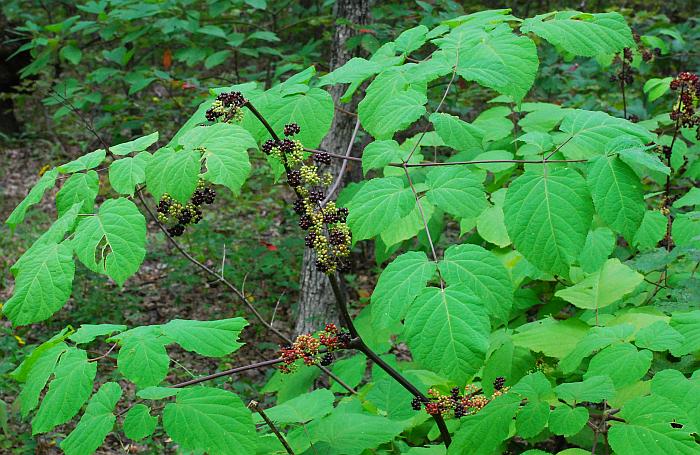Aralia racemosa L.
American Spikenard

Native
CC = 8
CW = 3
MOC = 39
© SRTurner
Aralia racemosa L.American Spikenard | |
 |
Native CC = 8 CW = 3 MOC = 39 |
© SRTurner |
|
Family - Araliaceae Habit - Taprooted perennial herb, sometimes woody at base. Stems - Erect to spreading, to 2.4 m, branched, pubescent, unarmed, green to purple.
Leaves - Alternate, ternately and then pinnately compound, petiolate, stipulate, usually 2 or more per stem. Petioles to 5 cm. Each pinna with 9-21 leaflets. Leaflets 2-18 cm long, ovate, acuminate, doubly toothed, dull green and short-hairy above, silvery green and short-hairy (mostly on veins) below.
Inflorescence - Terminal and axillary panicles or racemes of umbellets, to 20 cm long, the axis hairy. Some inflorescence branches subtended by small linear bracts to 3 mm long. Umbellets with +/-10 flowers. Pedicels to 6 mm long. Umbellets subtended by minute bracts to 2 mm long.
Flowers - Sepals 5 low, broadly triangular teeth. Petals oblong-elliptic, to 1 mm, white, glabrous, spreading. Stamens 5, alternating with the petals. Filaments white, glabrous, 1.1 mm long. Anthers whitish, 0.5 mm long. Ovary 5-locular, inferior Styles 5, 0.5 mm long, sometimes basally fused. Receptacle closed by an enlarged nectary. Hypanthium pubescent at the base but mostly glabrous, 1.3 mm long, greenish-white.
Fruits - Globose drupes, glabrous, to 6 mm in diameter, reddish purple to black, usually with 5 stones. Umbellet maturities usually asynchronous.
Flowering - June - August. Habitat - Rich wooded slopes, ravines, moist ledges and bluffs. Origin - Native to the U.S. Lookalikes - None. Other info. - This interesting species can be found mostly in the eastern 2/3 of Missouri. In the greater U.S. it is found across the upper Midwest and New England, with a disjunct region in the Southwest (primarily Arizona and New Mexico). It is not highly common, and since it seems to prefer areas difficult to access, such as ravines and bluff faces, it is not frequently encountered. When in flower or fruit the plant is easily recognized by its wide growth habit and striking inflorescences. Each leaf is very large, consisting of three primary branches, each of which is pinnately divided into large, toothed leaflets. The fruiting clusters have the unusual property of maturing the fruits at different times, giving them a distinctive speckled appearance. Photographs taken at Greer Spring, Oregon County, MO., 7-8-01, and in Pictured Rocks National Seashore, MI., 7-25-02 (DETenaglia); also at Taum Sauk State Park, Iron County, MO, 8-23-2009; Rockwoods Reservation, St. Louis County, MO, 9-20-2010, Shaw Nature Reserve, Franklin County, MO, 8-20-2011, Crawford Estate Conservation Area, Clark County, MO, 7-8-2017; Little Lost Creek Conservation Area, Warren County, MO, 6-6-2018; private property in Lincoln County, 8-8-2018; and LaBarque Creek Conservation Area, Jefferson County, MO, 8-27-2018 (SRTurner). |